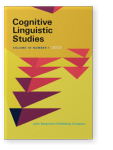Vol. 10:1 (2023) ► pp.146–172
When happiness can be luck
A comparative study of conceptual metaphors of happiness and luck in English, German, Greek, and Slovene
Previous studies have mainly focused on orientational, structural and ontological metaphors of happiness, and have not distinguished between luck and happiness; the latter in many languages originates from the former. This research aims to bridge these gaps by examining event-structure and object (possession) metaphors of 8000 hits for happiness and luck in the corpora of English, German, Greek, and Slovene. Our results suggest that luck is cross-linguistically perceived as non-pursuable and as an entity outside a person through numerous object (possession) metaphors of luck, or as a deity based on many stationary-ego metaphors of luck. In contrast, happiness is understood as pursuable (through frequent quest metaphors of happiness) and as an entity within a person. This research proposes an embodied cognition model which includes orientational, psychological, and culture-specific embodiments to account for the cross-linguistic universalities and differences. Our study could contribute to overall human understanding of these two important concepts.
Article outline
- 1.Introduction
- 2.Previous studies on happiness within the framework of cognitive linguistics
- 3.Methodology
- 3.1Theoretical framework and theoretical considerations
- a. moving-ego / quest metaphors
- b. stationary-ego metaphors
- c. transfer metaphors
- 3.2Data collection and analysis
- 3.1Theoretical framework and theoretical considerations
- 4.Results and discussion
- 4.1Universalities among languages
- 4.1.1 quest metaphors of happiness and luck across languages
- 4.1.2 object (possession) metaphors of happiness and luck across languages
- 4.1.3 stationary-ego metaphors of happiness and luck across languages
- 4.2Differences across languages
- 4.2.1 quest metaphors of happiness and luck across languages
- 4.2.2 transfer metaphors of happiness and luck across languages
- 4.3Common characteristics of Slovene and German metaphors of happiness and luck
- 4.1Universalities among languages
- 5.Further discussion: Our proposed embodied cognition model of the cross-linguistic universalities and differences
- 6.Conclusion
- Notes
-
References
